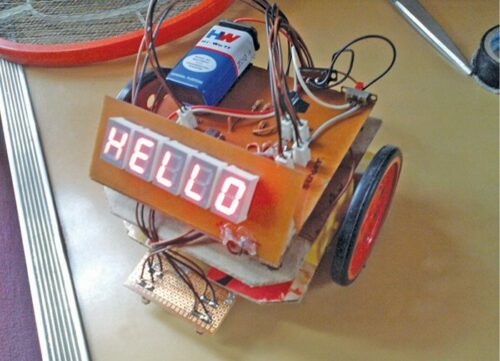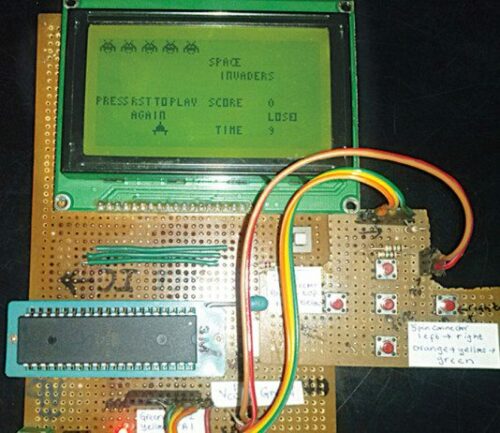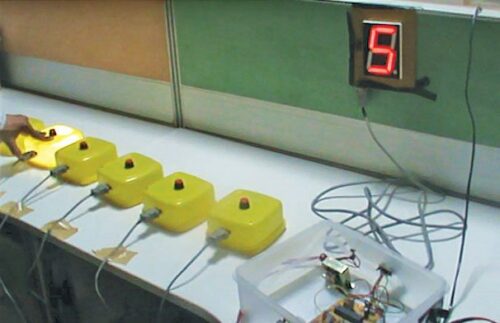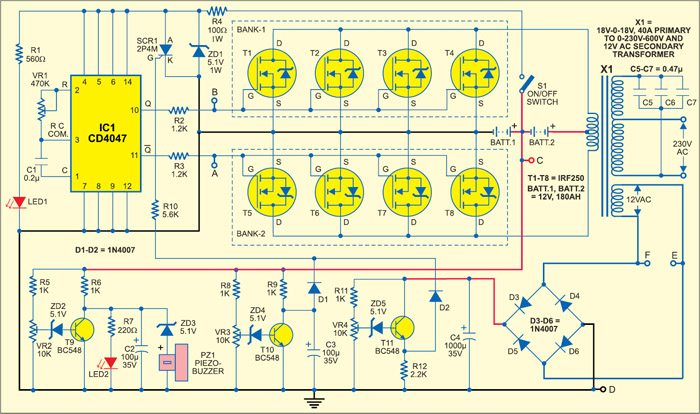Electronics projects are always in high demand. Students work on them to improve their skills, whereas hobbyists like the fun of meddling with technology. For professionals, it’s a different ball game altogether. We have an updated list of the top 50 mini-projects.
We compiled a list of 25+ interesting and practical mini-project ideas for you to work on. Let’s take a look.
1. Dual-Voltage Rechargeable Torch Light
The purpose of this circuit is to create a new topology with a good power factor maintained at AC voltage input, to provide good efficiency output to the battery, and to increase its life.
This mini project is available at: Make Your Own Dual-Voltage Rechargeable Torch Light
2. Line Follower Robot

We start the list off with a personal favorite. It describes a line-follower robot without a microcontroller, making this suitable for non-electronics engineers as well. This robot follows a particular color with the help of sensors. It is a simple project, which can be taken up as a classroom assignment. It lays the foundation for building your own behavior-based (simulated) robot.
This mini project is available at Simple Line-Following Robot
3. Hand Video Game

Playing space invaders on old black-and-white phones is a fond memory in many of our minds. How about bringing some of those back? This next project is a throwback to the time when we enjoyed it. Let’s get to designing the once-popular game using electronics. The fun part, after you are done designing, you get to play.
This mini projects idea is available at Hand Video Game
4. Fastest Finger First Project

This one would be the one for students to design and implement in college competitions. This fastest finger project assigns a number to all the buzzers displaying the number of the team to press the buzzer first on a 7-segment display. Built around a PIC microcontroller, this is just something we would all love in competitions as well.
This mini projects idea is available at Fastest finger first
5. Food Ordering System
Next, we have a restaurant menu ordering system. Whenever you go to a restaurant, you have difficulty interacting with the wait staff. Language is just one of the barriers. The menu items and types of confusing names keep adding to it. How about if, the next time you go to a restaurant, there is an electronic menu? I know that excites you. You can build one and pitch it to a nearby restaurant owner as well.
This mini project is available at Restaurant Menu Ordering System
6. Fancy Lighting – Mini Project
Festivals are always happening with us. If it’s not festivals, there is some family function. We have year-round family functions to keep us busy. How about in your next one, you handle the lighting system and show off some of those electronics skills? With this next project, you can nicely put some of those skills to use and be a core electronics engineer. All you need is an Arduino and a few external components.
This mini project is available at Fancy Lights Controller
7. GPS on ATmega
Smartphones and GPS are nothing new for techies. It not only gives information about the location but also information like time, date, height, and speed. It is so useful that most smartphones are embedded with it. However, for some of you out there, this next mini-project idea might be something to get your hands on. Based on ATmega 16A, this uses a GPS receiver.
This mini project is available at ATmega16A Based GPS Receiver
8. PC-based GPS
If working with ATmega gets too much for you, we have an alternative as well. This next project designs a system that connects a GPS module to a PC com port, which enables you to use GPS on a PC. A catch, you are going to have to be careful while handling the devices, as the pins of the com port might be too sensitive for rough usage.
This mini project is available at PC-Based GPS Receiver
9. LPG Leakage Detector
The circuit for an LPG leakage detector is readily available in the market, but it is extremely expensive and usually based on a microcontroller (MCU). This next mini project is for a low-cost circuit for an LPG detector that you can build easily. The next time there is a leakage, you can easily be on top of things.
This mini project is available at Low-Cost LPG Leakage Detector
10. Thermostat for Fridge
A thermostat is standard equipment for sensing the temperature of a system and maintaining it at a pre-defined point.
It is a regular feature in air-conditioners, room heaters, and refrigerators. Although some commercially-available refrigerators have inbuilt thermostats, the given mini projects idea is easy to build and automatically turns on or turns off the appliance at pre-set temperatures.
This mini project is available at Electronic Thermostat For Fridge
11. Fire Sensor – Mini Project
This is an ultra-sensitive fire sensor that activates an alarm when it detects fire. Thermistor-based fire alarms work well when the thermistor is in close vicinity. In this circuit, a sensitive PIN diode is used as a fire sensor for longer-range fire detection. This project can be set up as a safety precaution in your own house after its completion.
This mini project is available at PIN Diode Based Fire Sensor
12. RF-Controlled Robot
In this next mini project, we have a simple Arduino-board-based robot that can be driven remotely using an RF remote control. This robot can be built very quickly on a small budget. The RF remote control provides the advantage of a good controlling range (up to 100 meters with proper antennae) besides being omnidirectional.
This mini project is available at RF Controlled Robot
13. Faraday’s Guitar
Experimenting with the fundamentals of electrical and electronics is always interesting. This next mini project demonstrates Faraday’s law of electromagnetic induction and gives musical output.
The law talks about electromagnetic induction and the production of electromotive force (EMF) across a conductor when it is exposed to a varying magnetic field.
This mini project is available at Faraday’s Guitar
14. Sixth Sense Media Player
Sixth sense or gestural interface program is a popular term, especially in robotics and wearable computers. This next mini-project describes a hand-gesture-controlled media player. In such a media player, the user moves the hand in front of the camera. This project explains how to control the media player using a hand glove. It requires Windows Media Player, LabVIEW, Arduino, and an accelerometer.
This mini project is available at Sixth-Sense Media Player
15. DIY Power Bank for Smartphones
With the increase in our dependence on technology, we also require suitable power options as well. This next project designs a power bank used for charging smartphones. The circuit uses two integrated modules and a lithium-ion battery. The first module is a lithium-ion battery charger and the second is a DC-DC boost converter module.
This mini project is available at Power Bank for Smartphones
16. Sequential Timer for DC Motor Control
Most industrial processes require rotation of the motors in forward and reverse directions for desired periods. One good example is the automated bottle-filling plant. The stop time of the motor is calibrated based on the time required to fill the bottle and the time before the arrival of the next bottle.
This mini project is available at Sequential Timer for DC Motor Control
17. Sonar Water Level Meter
We all know a major part of the earth’s surface is filled with water. The water statistics for your house are on similar terms. You fill up your water tank every day again to refill it. This project helps you in designing a water level meter to check up on the amount of water in the tank. Earlier systems used metal which got rusted over time. Whereas this next system is contactless, resulting in no such problems.
This mini project is available at Sonar Water-Level Meter
18. Anti-Carjacking System
Imagine a criminal stopping your car by force and you are left with no option but to surrender the car. The criminal drives away your car but about 60 seconds later, the engine stops running on its own and won’t restart. Unable to use the dead vehicle, the perpetrator has to abandon it. All this because you are an engineer and were able to design a carjacking system and were able to save your vehicle.
This mini project is available at Anti-Carjack System
19. RF-based Multiple Device Control
This next project describes how to control electrical and electronic gadgets from a remote location using radio frequency (RF) transmission. An RF interface has a longer range making it suitable for usage. Sounds like a dream for lazy people, who won’t have to get up to switch off the lights at night. Possibly, you could install this system in your own house if you’d like.
This mini project is available at RF-Based Multiple Device Control
20. Battery Absorb and Float Charger
Most battery chargers stop charging the battery when it attains its maximum charging voltage set by the circuit. This mini project guides on a charger that charges the battery at the absorption voltage. The charger changes the output voltage to float voltage on achieving maximum charging voltage. Hence maintaining the battery at that voltage. I surely know some people that could use this project, how about you?
This mini project is available at 12V Battery Absorb and Float Charger
21. Dynamic Display using LED Strip
This next project designs a dynamic display that seems like an interesting prospective project. It describes a microcontroller-based dynamic display system using LED strips. Surface-mount device (SMD) LEDs are becoming popular because of their low power consumption and high brightness. Who knows when this might come in handy?
This mini project is available at Dynamic Display Using LED Strip
22. AC Switch Control With Opto-Triac
This circuit explains the need for an insulation layer for the control unit and the way to implement it for an AC switch device.
This mini projects idea is available at AC Switch Control With Opto-Triac
23. Plus-minus 5V Supply From 9V Battery
Op-amps require a dual-polarity supply for proper operation. When working with a battery supply, it becomes difficult to get a dual power supply for the op-amps. Presented here is a simple circuit that provides ±5V from a 9V battery.
This mini projects idea is available at Plus-minus 5V Supply From 9V Battery
24. Turn the Old Inverter Into An Emergency Power System
An inverter turned into an emergency power system, which turns on when the main supply fails and more importantly doesn’t turn on when the main supply is available.
This mini projects idea is available at DIY Emergency Power System
25. Audio Mixer With Multiple Controls
Presented here is an eight-input audio mixer circuit with bass, treble, volume, and balance controls, which you can use to balance sounds from all the sources until you have the desired mix. For capturing sound from various sources, the audio mixer employs up to eight microphones.
This mini projects idea is available at Audio Mixer With Multiple Controls
26. LED Scrolling Display
A light-dependent resistor (LDR) whose resistance is inversely proportional to the intensity of light is often used as a sensor in electronic projects that involve the use of light. This project uses an LDR to control the speed of a DC motor.
This mini projects idea is available at the LED Scrolling Display
27. 1Kw Sine Wave Inverter
Here we designed a simple sine wave inverter circuit that produces 50Hz quasi-sine wave output using a single IC CD4047 and some discrete components, which makes it a very cost-effective solution.

Complete project details are available at the sine wave inverter Circuit.
This article was recently updated on 08 December 2022.






An B. Tech in Electronics and communication engineer desires to set up his own production factory so what are the products that he can choose so that he Can gain Max. Profit and what are the basic that he has to undergo
We’d recommend you to join our forum (https://www.electronicsforu.com/forums) and post your question there. Our community members could help you out. Registering is just one-click and free through ‘FB Connect’.
I love the ideas of mini projects discuss above. It really give me the ideas about preparing my mini projects. Please keep posting these type of ideas eventually.
Thank you for your feedback. We will surely do that.
I have a thought but i want to implement this idea
-> storage tank intimation in our home. To off the switch when water is filled
Kindly check if this can be used: https://www.electronicsforu.com/electronics-projects/automatic-water-level-controller